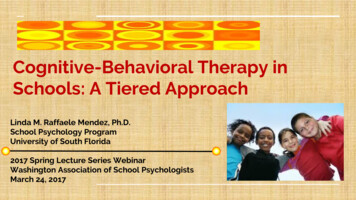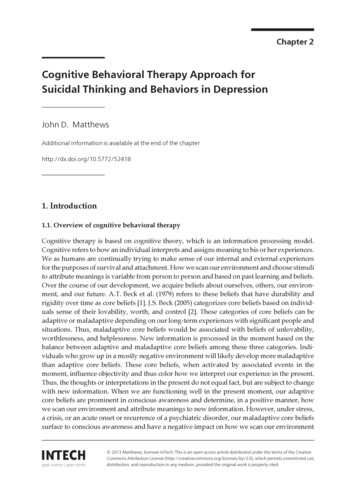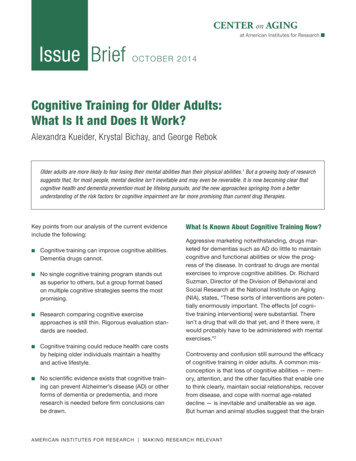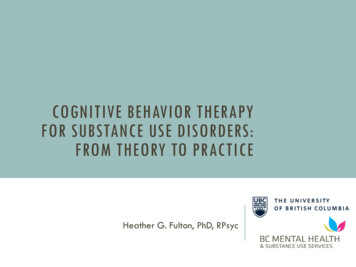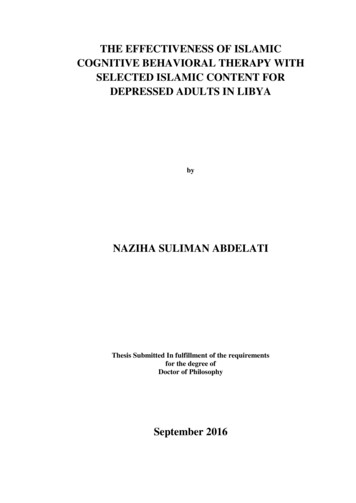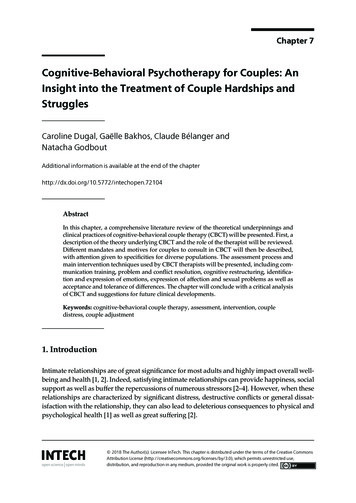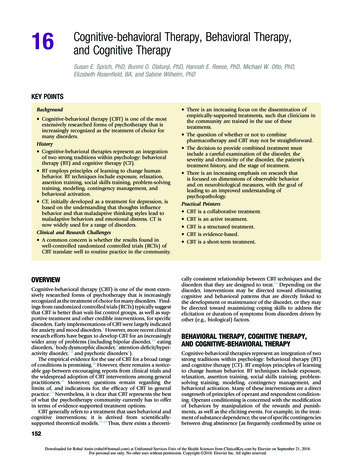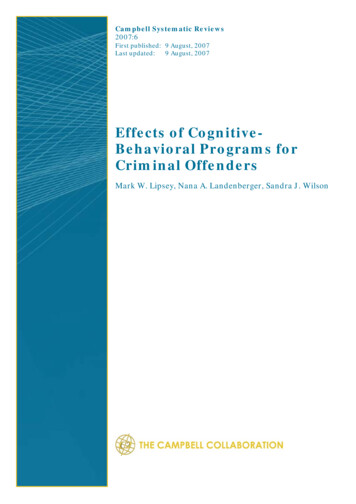
Transcription
Campbell Systematic Reviews2007:6First published: 9 August, 2007Last updated:9 August, 2007Effects of CognitiveBehavioral Programs forCriminal OffendersMark W. Lipsey, Nana A. Landenberger, Sandra J. Wilson
ColophonTitleInstitutionAuthorsDOINo. of pagesLast updatedCitationCopyrightEffects of cognitive-behavioral programs for criminal offendersThe Campbell CollaborationLipsey, Mark W.Landenberger, Nana A.Wilson, Sandra J.10.4073/csr.2007.6279 August, 2007Lipsey MW, Landenberger NA, Wilson SJ. Effects of cognitive-behavioralprograms for criminal offenders.Campbell Systematic Reviews 2007:6DOI: 10.4073/csr.2007.6 Lipsey et al.This is an open-access article distributed under the terms of the CreativeCommons Attribution License, which permits unrestricted use, distribution,and reproduction in any medium, provided the original author and source arecredited.KeywordsContributionsNone stated.Support/FundingNone stated.Potential Conflictsof InterestCorrespondingauthorNone.Mark Lipsey, PhDCenter for Evaluation Research and MethodologyVanderbilt Institute for Public Policy Studies1207 18th Ave. SouthNashville, TN 37212USATelephone: 1 615 343 2696E-mail: mark.lipsey@vanderbilt.edu
Campbell Systematic ReviewsEditors-in-ChiefMark W. Lipsey, Vanderbilt University, USAArild Bjørndal, Norwegian Knowledge Centre for the Health Services &University of Oslo, NorwayEditorsCrime and JusticeEducationSocial WelfareManaging EditorDavid B. Wilson, George Mason University, USAChad Nye, University of Central Florida, USARalf Schlosser, Northeastern University, USAJulia Littell, Bryn Mawr College, USAGeraldine Macdonald, Queen’s University, UK & Cochrane Developmental,Psychosocial and Learning Problems GroupKarianne Thune Hammerstrøm, The Campbell CollaborationEditorial BoardCrime and JusticeEducationSocial WelfareMethodsDavid Weisburd, Hebrew University, Israel & George Mason University, USAPeter Grabosky, Australian National University, AustraliaCarole Torgerson, University of York, UKAron Shlonsky, University of Toronto, CanadaTherese Pigott, Loyola University, USAPeter Tugwell, University of Ottawa, CanadaThe Campbell Collaboration (C2) was founded on the principle thatsystematic reviews on the effects of interventions will inform and helpimprove policy and services. C2 offers editorial and methodological support toreview authors throughout the process of producing a systematic review. Anumber of C2's editors, librarians, methodologists and external peerreviewers contribute.The Campbell CollaborationP.O. Box 7004 St. Olavs plass0130 Oslo, Norwaywww.campbellcollaboration.org
Effects of CBT for Offenders1Effects of Cognitive-Behavioral Programsfor Criminal OffendersAugust, 2007ReviewersMark W. Lipsey, Nana A. Landenberger, & Sandra J. WilsonCenter for Evaluation Research and MethodologyVanderbilt Institute for Public Policy Studies1207 18th Ave. SouthNashville, TN 37212 USATel: 615-343-2696Fax: 615-322-8081Email: mark.lipsey@vanderbilt.eduThis work is a Campbell Collaboration systematic review. The preparation of this review wasaided by the availability of data and resources from overlapping meta-analysis projects thathave been funded by the National Institute of Mental Health (NIMH), the Office of JuvenileJustice and Delinquency Prevention (OJJDP), and the Russell Sage Foundation.
Effects of CBT for Offenders2ContentsBackground for the Review. 4Criminal Thinking . 4Cognitive Behavioral Therapy . 4Representative CBT Programs . 5Prior Research on CBT for Offenders . 6Objectives of this Review. 6Methods of the Review . 7Criteria for Including Studies in the Review . 7Search Strategy for Identification of Studies . 8Selection of Studies . 9Data Management and Extraction. 9Findings . 10Description of Eligible Studies. 10Mean Effect of CBT on Recidivism . 12The Relationship of Method to Effect Size . 12Effect Size Variation Associated with Treatment and its Recipients . 14The Relative Influence of Different Moderator Variables . 19Effects of “Best Practice” CBT on Recidivism . 20Conclusions . 21Implications for Practice . 22Implications for Research. 23Plans for Updating . 23Conflict of Interest . 23References. 24Studies Included in the Systematic Review . 25
Effects of CBT for Offenders3List of TablesTable 1: Characteristics of Studies Included in the Meta-analysis. 10Table 2: Correlations between Study Method Characteristics and Recidivism Effect Sizes. 14Table 3: Relationships of Participant and Intervention Characteristics to Effect Size withSelected Method Variables Controlled. 15Table 4: Correlations Between Potential Moderator Variables Related to the Quality of CBTImplementation . 18Table 5: Regression Model for Effect Size Moderators Using Specific Type ofCBT Program . 20Table 6: Regression Model for Effect Size Moderators Using CBT Treatment Elements. 21List of FiguresOdds Ratio and 95% Confidence Interval for Recidivism Outcomes . 13
Effects of CBT for Offenders4Background for the ReviewCognitive-behavioral therapy (CBT) is among the more promising rehabilitative treatments forcriminal offenders. Reviews of the comparative effectiveness of different treatment approacheshave generally ranked it in the top tier with regard to effects on recidivism (e.g., Andrews et al.,1990; Lipsey & Wilson, 1998). It has a well-developed theoretical basis that explicitly targets“criminal thinking” as a contributing factor to deviant behavior (Beck, 1999; Walters, 1990;Yochelson & Samenow, 1976). And, it can be adapted to a range of juvenile and adultoffenders, delivered in institutional or community settings by mental health specialists orparaprofessionals, and administered as part of a multifaceted program or as a stand-aloneintervention. Meta-analysis has consistently indicated that CBT, on average, has significantpositive effects on recidivism. However, there is also significant variation across studies in thesize of those treatment effects. Identification of the moderator variables that describe the studycharacteristics associated with larger and smaller effects can further develop our understandingof the effectiveness of CBT with offenders. Of particular importance is the role such moderatoranalysis can play in ascertaining which variants of CBT are most effective. The objective of thissystematic review is to examine the relationships of selected moderator variables to the effectsof CBT on the recidivism of general offender populations.Criminal ThinkingOne of the most notable characteristics of criminal offenders is distorted cognition-- selfjustificatory thinking, misinterpretation of social cues, displacement of blame, deficient moralreasoning, schemas of dominance and entitlement, and the like (Beck, 1999; Dodge, 1993;Walters & White, 1989; Yochelson & Samenow, 1976). Offenders with such distorted thinkingmay misperceive benign situations as threats (e.g., be predisposed to perceive harmlessremarks as disrespectful or deliberately provocative), demand instant gratification, and confusewants with needs.Criminal thinking is often tied to a “victim stance” with offenders viewing themselves as unfairlyblamed, if not hated, and cast out from society (“everyone is against me,” or “society doesn’tgive me a chance”) while failing to see how their antisocial behavior may have contributed totheir problems. These thinking patterns may also be supported by offenders’ entrenchment in anantisocial subculture (e.g., street or prison codes) where otherwise dysfunctional assumptionsabout how one should behave may in fact be adaptive (e.g., “you have to punish people formessing with you or they won’t respect you”).Cognitive-Behavioral TherapyCognitive-behavior therapy is based on the assumption that cognitive deficits and distortionscharacteristic of offenders are learned rather than inherent. Programs for offenders, therefore,emphasize individual accountability and attempt to teach offenders to understand the thinkingprocesses and choices that immediately preceded their criminal behavior. Learning to selfmonitor thinking is typically the first step, after which the therapeutic techniques seek to helpoffenders identify and correct biased, risky, or deficient thinking patterns. All cognitivebehavioral interventions, therefore, employ a set of structured techniques aimed at buildingcognitive skills in areas where offenders show deficits and restructuring cognition in areaswhere offenders’ thinking is biased or distorted. These techniques typically involve cognitiveskills training, anger management, and various supplementary components related to socialskills, moral development, and relapse prevention.
Effects of CBT for Offenders5Cognitive skills training. Cognitive skills training aims to teach such thinking skills asinterpersonal problem-solving (with information gathering, developing alternative solutions, andevaluating outcomes as crucial steps), abstract thinking, critical reasoning, causal thinking, goalsetting, long-term planning, and perspective taking. Often role-play or practice in real situationsis used to help consolidate new ways of coping with situations that tend to prompt maladaptivehabits and aggressive or criminal behavior.Anger management. Anger management training typically focuses on teaching offenders tomonitor their patterns of automatic thoughts to situations in which they tend to react with angeror violence. Various strategies are then rehearsed for assessing the validity of those “hot” or“trigger” thoughts. Learning to substitute accurate interpretations for biased ones and toconsider non-hostile explanations of others’ behavior are the key parts of most angermanagement programs.Supplementary components. CBT programs differ in their emphasis. Some are geared mainlytoward anger control and building conflict resolution skills. Others center on assuming personalresponsibility for crimes (e.g., challenging offenders’ tendency to justify their behavior byblaming the victim), and on developing victim empathy (e.g., by correcting their minimization ofthe harm they caused). Along with these primary emphases, CBT programs often add selectedsupplementary components such as social skills training, moral reasoning exercises, or relapseprevention planning. Relapse prevention is increasingly popular and is aimed at developingcognitive risk-management strategies along with a set of behavioral contracts for avoiding ordeescalating the precursors to offending behavior (e.g., high-risk situations, places, associates,or maladaptive coping responses).Representative CBT ProgramsPrototypical examples of CBT programs for offenders include the following: The Reasoning and Rehabilitation program (Ross & Fabiano, 1985) is organized aroundexercises (e.g., Critical Thinking, Social Perspective-Taking) that focus on “modifying theimpulsive, egocentric, illogical and rigid thinking of the offenders and teaching them to stopand think before acting, to consider the consequences of their behavior, to conceptualizealternative ways of responding to interpersonal problems and to consider the impact of theirbehavior on other people, particularly their victims” (Ross et al., 1988: 31). Moral Reconation Therapy (Little & Robinson, 1986) is based on Kohlberg’s stages of moraldevelopment and uses a series of group and workbook exercises designed to raise themoral reasoning level of offenders stepwise through 16 graded moral and cognitive stages. Aggression Replacement Training (Goldstein & Glick, 1987; 1994) is comprised of threecomponents–Skillstreaming, Anger Control Training, and Moral Education. Skillstreamingteaches prosocial behaviors through modeling and role-playing. Anger Control Traininginstructs offenders in self-control by having them record anger-arousing experiences,identify “trigger” thoughts, and apply anger control techniques. Moral Education exposesoffenders to moral dilemmas in a discussion format aimed at advancing the level of moralreasoning. Thinking for a Change (Bush et al., 1997) consists of 22 sessions of group exercises andhomework organized around: (a) understanding that thinking controls behavior; (b)understanding and responding to feelings of self and others; and (c) problem-solving skills. Cognitive Interventions Program (National Institute of Corrections, 1996) is a 15 lessoncognitive restructuring curriculum that guides offenders to see their behaviors as the directresult of choices they make. The program leads participants to recognize how distortionsand errors in thinking (e.g., victim stance, super-optimism, failure to consider injury to
Effects of CBT for Offenders 6others) and antisocial attitudes influence these choices. Alternative thinking styles areintroduced and practiced to create more options from which to choose.Relapse prevention approaches to substance abuse (Marlatt & Gordon, 1985) have beenadapted for treating aggression and violence (e.g., Cullen & Freeman-Longo, 2001). Theseprograms incorporate cognitive skills and cognitive restructuring elements into a curriculumthat builds behavioral strategies to cope with high-risk situations and halt the relapse cyclebefore lapses turn into a full relapse.Prior Research on CBT for OffendersSeveral well conducted meta-analyses have identified cognitive-behavioral therapy (CBT) as aparticularly effective intervention for reducing the recidivism of juvenile and adult offenders.Pearson, Lipton, Cleland, and Yee (2002), for instance, conducted a meta-analysis of 69research studies covering both behavioral (e.g., contingency contracting, token economy) andcognitive-behavioral programs. They found that the cognitive-behavioral programs were moreeffective in reducing recidivism than the behavioral ones, with a mean recidivism reduction fortreated groups of about 30%. Similarly, a meta-analysis by Wilson, Bouffard, and MacKenzie(2005) examined 20 studies of group-oriented cognitive behavioral programs for offenders andfound that CBT was very effective for reducing their criminal behavior. In their analysis,representative CBT programs showed recidivism reductions of 20-30% compared to controlgroups.Although these meta-analyses provide strong indications of the effectiveness of cognitivebehavioral treatment for offenders, they encompassed considerable diversity within the range ofoffender types, outcome variables, quality of study design, and (especially in Pearson et al.,2002) variations in what was counted as a cognitive-behavioral treatment. A more circumscribedmeta-analysis conducted by Lipsey, Chapman, and Landenberger (2001) examined 14experimental and quasi-experimental studies that emphasized cognitive change as the definingcondition of CBT, considered only effects for general offender samples, and focused onreoffense recidivism as the treatment outcome. The results showed that the odds of recidivatingfor offenders receiving CBT were only about 55% of that for offenders in control groups.Landenberger and Lipsey (2005; Lipsey & Landenberger, 2006) then focused further on anupdated and overlapping set of studies and again found that the mean recidivism for thetreatment groups was significantly lower than that of the control groups.These prior meta-analytic reviews clearly identify positive effects of CBT on the recidivism ofoffenders although, in some cases, they define CBT rather broadly and include variants targetedon different types of offenders. These meta-analyses also provide comparisons between theeffects of studies with higher and lower ratings of global methodological quality and make somelimited comparisons between different CBT interventions (e.g., different named programs).However, they provide little detailed analysis of the many factors that might differentiate studiesshowing larger effects from those showing smaller ones.Objectives of this ReviewMeta-analysis has consistently indicated that CBT, on average, has significant positive effectson recidivism. However, there is also significant variation across studies in the effect sizes thatcontribute to those mean effect size values. The purpose of this systematic review is to focus ona clearly specified domain of CBT treatment with offenders and, within that domain, examine therole of various moderator variables in the variation in treatment effects. For this purpose, therelevant interventions are restricted to those that apply treatment strategies explicitly directedtoward cognitive change and take an unambiguously cognitive-behavioral approach to bringing
Effects of CBT for Offenders7about that change. In addition, only the effects on general offender samples are considered.CBT interventions for specialized offender groups (e.g., sex offenders, batterers, and substanceabusers) typically involve distinctive features tailored to those offenders and both the effects ofthese interventions and the moderators of those effects may also be distinctive. The mainissues for this review, therefore, are the effects of primary, explicit CBT on the recidivism ofgeneral offenders and the moderators of those effects. Within this domain there are numerousvariants of CBT, including the different named CBT programs listed above and different optionalsupplementary components. Whether these variants have differential effects on recidivism is ofparticular interest.Methods of the ReviewCriteria for Including Studies in the ReviewIn order to have a sufficient number of studies to permit examination of between-studydifferences, an especially thorough search was made of the available research. To assist inexpanding the number of studies, quasi-experimental studies were included as well asrandomized field experiments. Studies were assessed and selected for this meta-analysis if theymet the following criteria:Intervention. The treatment under investigation was a variant of cognitive-behavioral therapyrepresenting or substantially similar to such recognized “brand name” CBT programs asReasoning and Rehabilitation (Ross & Fabiano, 1985), Moral Reconation Therapy (Little &Robinson, 1986), Aggression Replacement Training (Goldstein & Glick, 1987), the Thinking fora Change curriculum (Bush, Glick & Taymans, 1997), and the Cognitive Interventions Program(NIC, 1996). In particular, it was directed toward changing distorted or dysfunctional cognitions(cognitive restructuring) or teaching new cognitive skills and involved therapeutic techniquestypically associated with CBT, e.g., structured learning experiences designed to affect suchcognitive processes as interpreting social cues, monitoring one’s own thought processes,identifying and compensating for distortions and errors in thinking, reasoning about right andwrong behavior, generating alternative solutions, and making decisions about appropriatebehavior. If CBT was offered in the context of a multimodal program that simultaneouslyprovided other services, the CBT must have been provided to all participants and constitute amajor component of the program.Participants. The recipients of the intervention were criminal offenders, either juveniles or adults,treated while on probation, incarcerated/institutionalized, or during aftercare/parole. Offenderswere drawn from a general offender population; offender samples that were selected for, orrestricted to, persons committing specific types of offenses (e.g., sex offenses, DUI, drugoffenses, status offenses) were not included.Outcome measures. The study reported criminal offending subsequent to treatment as anoutcome variable. Outcome results were presented in a quantitative form that permittedcomputation or reasonable estimation of an effect size statistic representing the difference inrecidivism rates between treated and untreated offenders.Research methods. The study used a randomized or quasi-experimental design that compareda CBT treatment condition with a control condition that did not include CBT treatment. Quasiexperimental designs were eligible only if subjects in the treatment and control conditions werematched, statistically controlled, or compared on one or more of the following pretreatment riskrelated variables: prior offense history, recidivism risk, gender, race, or age. Group equivalencewas coded for any of these variables that were reported and that information was used to create
Effects of CBT for Offenders8a moderator variable (“design problem”) that was examined in the meta-analysis. To eliminateexplicit self-selection as a biasing factor in group assignment, studies were not included if thecontrol groups were created with individuals who began CBT but dropped out prior tocompleting treatment or who were offered CBT and refused. Control groups could representplacebo, wait-list, no treatment, or “treatment as usual” conditions, with the latter restricted tocases of clearly routine probation, institutional, or aftercare/parole practices.Source. Both published and unpublished studies were eligible for inclusion, conducted in anycountry, and reported in any language.Search Strategy for Identification of StudiesAn initial set of eligible studies came from those assembled and analyzed for the Lipsey,Chapman, and Landenberger (2001) and Lipsey and Landenberger (2006) meta-analyses. Thisnumber was expanded through a comprehensive search using the following procedures.Meta-analysis databases. The first author (Lipsey) has constructed a meta-analysis database ofcoded studies for interventions with juvenile offenders based on a comprehensive search forstudies reported in 2002 or earlier. All the studies in that database were reviewed for eligibility.In addition, the studies in a second database of interventions with adult offenders that is nearingcompletion were reviewed for eligibility.Database searches. Computerized bibliography searches were conducted for studies reportedfrom 1965 through 2005. To the best of our knowledge, the first systematic applications of CBTto offenders were developed and published in the mid-1970s (e.g., Yochelson & Samenow,1976); searching back to 1965 was aimed at ensuring that none were missed. The keywords forsearching were concatenations of words describing the population (e.g., inmates, offenders),CBT treatment (e.g., cognitive, CBT, criminal thinking), and effectiveness research (e.g.,outcomes, evaluation, effectiveness). The databases searched included the CampbellCollaboration Social, Psychological, Educational and Criminological Trials Register (C2SPECTR), Dissertation Abstracts Online, ERIC, MEDLINE, The National Criminal JusticeReference Service (NCJRS), PsychInfo/PsychLit, Sociological Abstracts, and a number ofothers.Cross-referencing of bibliographies. Relevant review articles, meta-analyses, and primarystudies reviewed for eligibility were scanned for citations to potentially eligible studies.Internet searches. Relevant government websites (e.g., NIJ, NIC, OJJDP, Home Office) as wellas foundation, professional associations and policy research firm websites were searched. Inaddition, keyword searches were conducted using search engines such as google.com.Journals. Vanderbilt University subscribes to a large number of electronic journals and the fulltext of the journals judged relevant was searched with selected keywords. Major journalspublishing empirical studies related to crime and delinquency were also hand searched foreligible studies.Informal sources. Unpublished results from evaluations of two CBT programs were availablefrom N. Landenberger, and several colleagues alerted us to eligible studies that were notaccessible through the above channels.
Effects of CBT for Offenders9Selection of StudiesAbstracts of the studies found through the search procedures were screened for relevance byone of the authors. Documents that were not obviously ineligible or irrelevant (based on theabstract review) were retrieved for final eligibility screening from the Vanderbilt UniversityLibraries, Interlibrary Loan, ERIC, University Microfilms, and government documents sources.Final determination of eligibility for all studies irrespective of source was made by one of theauthors using the full study report document(s). Any ambiguities or questions about eligibilitywere resolved through discussion.Although some research suggests that two reviewers might increase accuracy in identifyingpotentially eligible studies from abstracts obtained through bibliographic searches (Edwards, etal., 2002), our experience is that most abstracts do not provide enough detail to allow reviewersto make reliable judgments about whether a study meets the review criteria. Thus, we reviewedabstracts mainly to eliminate those clearly irrelevant and deferred the final determination untilthe entire study report was screened. While this required retrieving more documents thaneventually ended up in the review, it allowed us to make eligibility decisions based on the mostcomplete information about a study that was available.The search for CBT studies on adult offenders produced 2,947 study citations with 771 reportsjudged promising enough to retrieve for closer examination. The search for juvenile offenderstudies produced 1,487 study citations with 299 reports retrieved. Review of the retrievedstudies by one or more of the authors ultimately identified 58 studies meeting the criteria forinclusion in the present systematic review.Data Management and ExtractionThough not all potentially interesting moderator variables were reported well enough in thesource studies to allow systematic comparison, a detailed coding protocol was applied to extractas much relevant information for analysis as possible from each report on the 58 eligiblestudies. The second author (Landenberger) coded all studies with the results reviewed by asecond coder and all questionable entries decided through discussion. Table 1, presented later,shows the major coding categories used for descriptive information.Recidivism outcomes were reported in several different forms but, in virtually all instances,either the proportions of offenders in each research condition who recidivated were specified orinformation was provided from which the proportions could be estimated. When more than onerecidivism outcome was reported, only one was selected for analysis using criteria thatmaximized cross-study similarity on the variables and times of measurement. This procedurefavored rearrest recidivism, then reconviction and incarceration in that order, and the measuretaken closest to 12 months post-treatment. The remaining differences in the form of therecidivism outcomes were identified in coded variables and included in the moderator analysisto examine and control for any variation from those sources.The selected recidivism outcomes were coded as odds ratios representing the odds of“success” (not recidivating) for treatment group participants relative to the odds for controlparticipants. For binary outcomes, the odds ratio provides an effect size statistic that hasfavorable properties and yields readily interpretable results (Haddock, Rindskopf, & Shadish,1998). Statistical analysis with odds ratios is facilitated if they are represented by their log, sothe logged odds ratios were used in all
management programs. Supplementary components. CBT programs differ in their emphasis. Some are geared mainly toward anger control and building conflict resolution skills. Others center on assuming personal responsibility for crimes (e.g., challenging offenders' tendency to justify their behavior by
